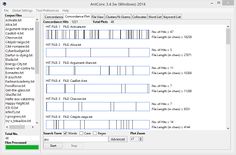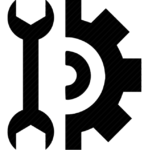AntConc
AntConc
The last edition of this page was on: 2014/11/14
The Completion level of this page is : Low
The last edition of this page was on: 2014/11/14 The Completion level of this page is : Low
SHORT DESCRIPTION
AntConc is a freeware concordance program for Windows, Macintosh OS X, and Linux.
The software includes seven tools:
Concordance Tool: shows search results in a 'KWIC' (KeyWord In Context) format.
Concordance Plot Tool: shows search results plotted as a 'barcode' format. This allows you to see the position where search results appear in target texts.
File View Tool: This tool shows the text of individual files. This allows you to investigate in more detail the results generated in other tools of AntConc.
Clusters/N-Grams: hows clusters based on the search condition. In effect it summarizes the results generated in the Concordance Tool or Concordance Plot Tool. The N-Grams Tool, on the other hand, scans the entire corpus for 'N' (e.g. 1 word, 2 words, …) length clusters. This allows you to find common expressions in a corpus.
Collocates: shows the collocates of a search term. This allows you to investigate non-sequential patterns in language.
Word List: counts all the words in the corpus and presents them in an ordered list. This allows you to quickly find which words are the most frequent in a corpus.
Keyword List: shows the which words are unusually frequent (or infrequent) in the corpus in comparison with the words in a reference corpus. This allows you to identify characteristic words in the corpus, for example, as part of a genre or ESP study.
TOOL CHARACTERISTICS
Usability
Tool orientation
Data mining type
Manipulation type
IMPORT FORMAT : HTML, TXT, XML
EXPORT FORMAT :
| Tool objective(s) in the field of Learning Sciences | |
|
☑ Analysis & Visualisation of data |
☑ Providing feedback for supporting instructors: |
Tool can perform:
- Data extraction of type:
- Transformation of type:
- Data analysis of type: Data mining methods and algorithms
- Data visualisation of type: (These visualisations can be interactive and updated in "real time")
ABOUT USERS
Tool is suitable for:
Required skills:
STATISTICS: N/A
PROGRAMMING: N/A
SYSTEM ADMINISTRATION: N/A
DATA MINING MODELS: N/A
FREE TEXT
| Tool version : AntConc (blank line) Developed by : | 
|
SHORT DESCRIPTION
AntConc is a freeware concordance program for Windows, Macintosh OS X, and Linux.
The software includes seven tools:
Concordance Tool: shows search results in a 'KWIC' (KeyWord In Context) format.
Concordance Plot Tool: shows search results plotted as a 'barcode' format. This allows you to see the position where search results appear in target texts.
File View Tool: This tool shows the text of individual files. This allows you to investigate in more detail the results generated in other tools of AntConc.
Clusters/N-Grams: hows clusters based on the search condition. In effect it summarizes the results generated in the Concordance Tool or Concordance Plot Tool. The N-Grams Tool, on the other hand, scans the entire corpus for 'N' (e.g. 1 word, 2 words, …) length clusters. This allows you to find common expressions in a corpus.
Collocates: shows the collocates of a search term. This allows you to investigate non-sequential patterns in language.
Word List: counts all the words in the corpus and presents them in an ordered list. This allows you to quickly find which words are the most frequent in a corpus.
Keyword List: shows the which words are unusually frequent (or infrequent) in the corpus in comparison with the words in a reference corpus. This allows you to identify characteristic words in the corpus, for example, as part of a genre or ESP study.
TOOL CHARACTERISTICS
| Tool orientation | Data mining type | Usability |
|---|---|---|
| This tool is designed for general purpose analysis. | This tool is designed for Text mining. | Authors of this page consider that this tool is easy to use. |
| Data import format | Data export format |
|---|---|
| HTML, TXT, XML. | . |
| Tool objective(s) in the field of Learning Sciences | |
|
☑ Analysis & Visualisation of data |
☑ Providing feedback for supporting instructors: |
Can perform data extraction of type:
Can perform data transformation of type:
Can perform data analysis of type:
Data mining methods and algorithms
Can perform data visualisation of type:
(These visualisations can be interactive and updated in "real time")
ABOUT USER
| Tool is suitable for: | ||||
| Students/Learners/Consumers:☑ | Teachers/Tutors/Managers:☑ | Researchers:☑ | Organisations/Institutions/Firms:☑ | Others:☑ |
| Required skills: | |||
| Statistics: | Programming: | System administration: | Data mining models: |
OTHER TOOL INFORMATION

|
| AntConc 3.4.3w(Windows)2014.jpg |
| AntConc |
| AntConc |
| Free&Closed source |
| http://www.laurenceanthony.net/software.html#antconc |
| AntConc is a freeware concordance program for Windows, Macintosh OS X, and Linux.
The software includes seven tools: Concordance Tool: shows search results in a 'KWIC' (KeyWord In Context) format. Concordance Plot Tool: shows search results plotted as a 'barcode' format. This allows you to see the position where search results appear in target texts. File View Tool: This tool shows the text of individual files. This allows you to investigate in more detail the results generated in other tools of AntConc. Clusters/N-Grams: hows clusters based on the search condition. In effect it summarizes the results generated in the Concordance Tool or Concordance Plot Tool. The N-Grams Tool, on the other hand, scans the entire corpus for 'N' (e.g. 1 word, 2 words, …) length clusters. This allows you to find common expressions in a corpus. Collocates: shows the collocates of a search term. This allows you to investigate non-sequential patterns in language. Word List: counts all the words in the corpus and presents them in an ordered list. This allows you to quickly find which words are the most frequent in a corpus. Keyword List: shows the which words are unusually frequent (or infrequent) in the corpus in comparison with the words in a reference corpus. This allows you to identify characteristic words in the corpus, for example, as part of a genre or ESP study. |
| General analysis |
| Students/Learners/Consumers, Teachers/Tutors/Managers, Researchers |
| N/A |
| N/A |
| N/A |
| N/A |
| Text mining |
| Data analysis |
| Data mining methods and algorithms |
| HTML, TXT, XML |
| easy to use |
| Low |
Manual: http://www.laurenceanthony.net/software/antconc343/AntConc_readme.pdf
The same author also produced other useful software, e.g. a PDF to txt converter
